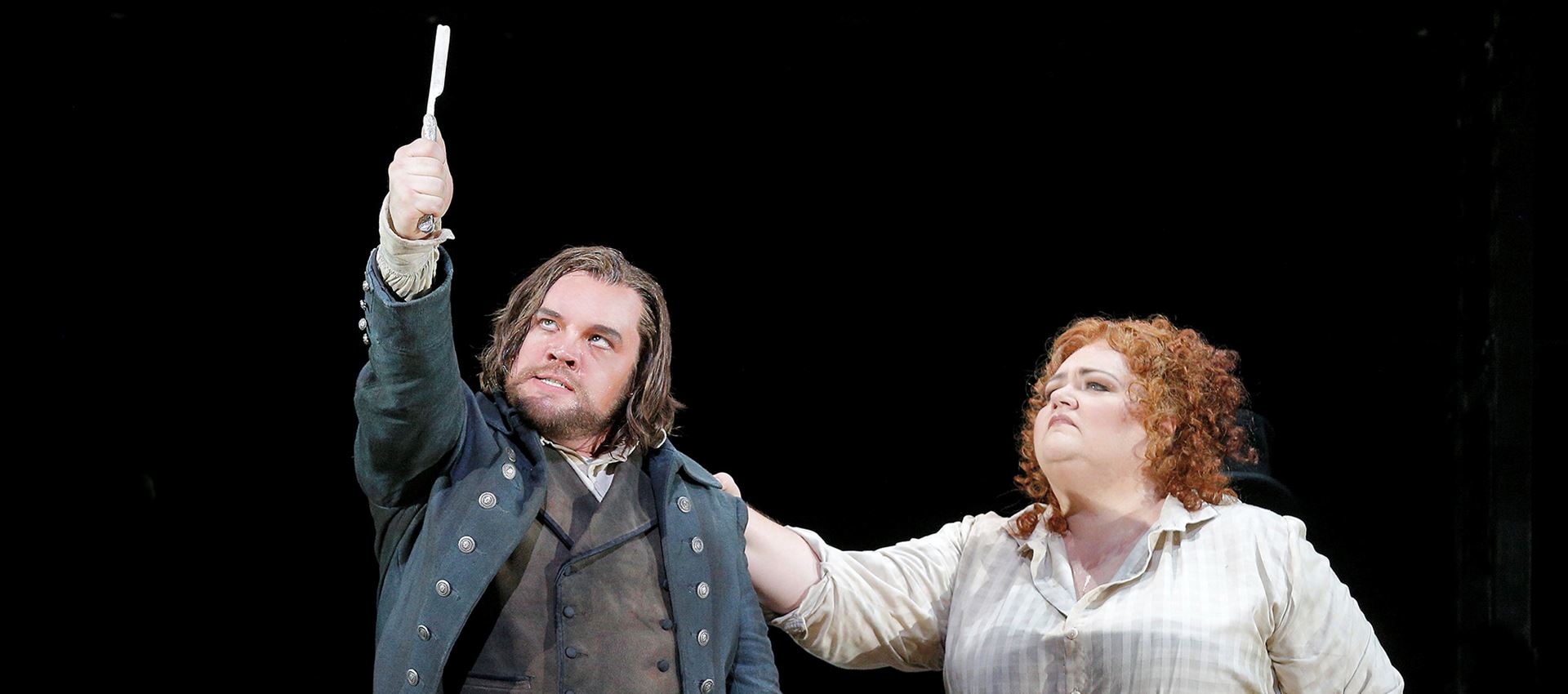
Broadway and Opera
Broadway musicals and opera both have long and storied histories. It’s no surprise that these two art forms, both of which rely on musical storytelling, have had many opportunities to intertwine! Let’s take a closer look at three of Broadway’s biggest shows and how they connect to opera.
Sweeney Todd: The Demon Barber of Fleet Street by Stephen Sondheim, 1979
Sweeney Todd
Creating a 'modern American opera'
Sweeney Todd: The Demon Barber of Fleet Street tells the story of a barber who has just returned to London after 15 years in jail for a crime he didn’t commit. Driven mad by injustice and the loss of his loved ones, Todd swears revenge and begins using his razor to do more than shave, killing customers and delivering the bodies to his neighbor Mrs. Lovett who uses them in her meat pie shop. Upon seeing Sweeney Todd’s opening night on Broadway, Schuyler Chapin, former general manager of the Metropolitan Opera, dubbed the Sondheim musical “a modern American opera.”
Sweeney Todd has been showcased at various opera houses since its Broadway debut—from the Houston Grand Opera and New York City Opera in 1984 to our own San Francisco Opera in 2015! Even outside of opera houses, the musical often features opera singers in the lead roles.
But despite the operatic connections and despite the fact that the vast majority of the show is sung through—only 20% of the show consists of dialogue, significantly less than most musicals—Sweeney Todd is usually classified as a musical rather than an opera. Even though Sondheim referred to the piece as a “dark operetta,” his own musical stylings and background as a musical theater composer resulted in a score that has scales, harmonies, syncopation, and style that echo a classic Broadway sound rather than an operatic one.
Still, that doesn’t mean there aren’t operatic elements within Sweeney Todd’s music. The most noteworthy is Sondheim’s use of leitmotifs and interwoven melodies—both techniques pioneered by Richard Wagner in his Ring cycle (Der Ring des Nibelungen)—which Sondheim utilized not only in Sweeney Todd but also throughout his oeuvre. With musicals like Sweeney Todd, Sondheim demonstrated that it was possible to blend classical elements of opera and musical theater in order to create new works that moved beyond the strict boundaries of genre.
Broadway Opera Musicals
The Phantom of the Opera by Andrew Lloyd Webber, 1986
Bringing opera into a Broadway musical
The Phantom of the Opera isn’t an opera itself—though people often think it is. Instead, it’s a musical with opera at its center. Based on a novel by French author Gaston Leroux, The Phantom of the Opera takes place in the real-life Paris Opera house and its underground labyrinth. The plot centers around the Phantom, a mysterious masked musician who lives in the opera house’s catacombs and becomes obsessed with young soprano Christine Daaé. From there, a twisted plot of romance, violence, confusion, and mayhem ensues as the Phantom does all he can to ensure that Christine becomes the opera house’s star—and his bride.
This plot, along with Andrew Lloyd Webber’s music, has helped make Phantom a sensation on both sides of the Atlantic. After previews in Webber's hometown of Sydmonton, Phantom made its debut in London's West End in 1986, becoming one of the most popular shows in the theater district's history. It currently reigns as the longest running show on Broadway, where it opened in 1988.
Not only does The Phantom of the Opera revolve around opera, it also features scenes from three fictional operas with direct ties to real ones.
The musical’s first opera, Hannibal, lightly satirizes the Paris Opera’s production of Giuseppe Verdi’s Aida. But key characters and locations are changed to take the action out of Egypt and into the Roman Empire. The second, Il Muto, is based on the Figaro plays by Pierre Beaumarchais, which are also the basis of two real operas: Wolfgang Amadeus Mozart’s The Marriage of Figaro and Gioachino Rossini’s The Barber of Seville. The third fictional opera, Don Juan Triumphant, is the Phantom's own composition: a dissonant, dark work that draws heavily from Mozart’s Don Giovanni.
Although Phantom is by no means an opera in itself, it serves as an enjoyable bridge between the two art forms and highlights the level of overlap that is possible between them.
Rent by Jonathan Larson, 1996
Transforming an iconic opera into musical theater
For the many fans who have worshipped Jonathan Larson’s groundbreaking rock musical Rent since its debut at the Public Theater 25 years ago, it’ll come as no surprise to hear that the sung-through show is a modernized take on Giacomo Puccini’s La Bohème. The parallels are everywhere. Where La Bohème follows a group of poor young artists plagued by poverty and tuberculosis in 1800s Paris, Rent follows a group of poor young artists plagued by poverty and HIV/AIDs in the 1990s in New York City’s East Village. And that’s just the tip of the iceberg.
Larson also took music from La Bohème and carefully repurposed it, fitting Puccini’s classic tunes into Rent’s modern-rock style. For example, in “Light My Candle,” the ballad that the lovers Roger and Mimi sing when they first meet, Larson draws melodies from Puccini's aria “Che gelida manina,” which marks the moment when Rodolfo and Mimì meet in La Bohème.
Another great example is Larson’s use of one of the most famous pieces of music from La Bohème: Musetta’s Waltz, or “Quando me’n vo,” which appears many times throughout Rent. The most direct reference occurs when Roger plays a rock guitar version of the aria's theme. His roommate Mark quips that instead he should write something that “doesn’t remind us of Musetta’s Waltz.”
Although there’s no denying that there are significant differences between Rent and the opera on which it’s based, their underlying themes are the same. Love and loss, life and death, poverty and prosperity, and what it means to live la vie bohème are all topics that resonate as much today as they did exactly 100 years before Rent’s premiere, when audiences experienced Puccini’s La Bohème for the first time in 1886.
Broadway and Opera: A Lasting Relationship
Broadway and opera may feel like separate entities, but the connections between the two are undeniable. Both draw on a theater tradition that stretches back to Ancient Greece, and both use music and performance to bring powerful stories to the stage. Opera—along with burlesque, vaudeville, and other art forms—ultimately lay the groundwork for the modern musical theater seen on Broadway today.
The three operas highlighted here serve as a small sample of the many works that draw direct inspiration from operatic predecessors. Musicals like Into the Woods, Hamilton, Les Misérables, and more might not exist without the performing arts culture fostered, in part, through opera.
Want to learn more about opera? Check out our other blogs for A Brief History of Opera, 5 Things to Know About Opera, and much more. If you're ready to dive even deeper, take a look at our website and see what's coming to San Francisco Opera!


